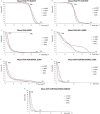Is there a preferred IMRT technique for left-breast irradiation?
- PMID: 26103488
- PMCID: PMC5690145
- DOI: 10.1120/jacmp.v16i3.5266
Is there a preferred IMRT technique for left-breast irradiation?
Abstract
Not all clinics have breath-hold radiotherapy available for left-breast irradiation. However intensity-modulated radiotherapy (IMRT) has also been advocated as a means of lowering heart doses. There is currently no large-scale, long-term follow-up data after breast IMRT and, since dose distributions may differ from classic tangent-based radiotherapy, caution is needed to avoid unexpected worsening of the late toxicity profile. We compared four IMRT techniques for free-breathing left-breast irradiation. Consistent with the aforementioned concerns, our goal in planning was to prioritize organ at risk (OAR) sparing in a way that mimicked tangent-based radiotherapy. Ten simultaneous integrated boost treatment plans (PTVelective = 15 × 2.67 Gy; PTVboost = 15 × 3.35 Gy) were created using 1) hybrid-IMRT (H-IMRT), 2) full IMRT (F-IMRT), and 3) volumetric-modulated arc therapy with two partial arcs (2ARC) and 4) six partial arcs (6ARC). Reduction in OAR mean and low dose was prioritized. End-points included OAR sparing (e.g., heart, left anterior descending artery [LAD+3 mm], lungs, and contralateral breast) and PTV coverage/dose homogeneity. Under these conditions we found the following: 1) H-IMRT provided the best mean and low dose OAR sparing, PTVelective coverage (mean V95% = 98%), PTVboost coverage (V95% = 98%), and PTV homogeneity. However, it delivered most intermediate-high dose to the heart, LAD+3 mm and ipsilateral lung; 2) 6ARC had the best intermediate-high dose sparing, followed by F-IMRT, but this was at the expense of more dose in the contralateral lung and breast and worse PTV coverage (PTVelective mean V95% = 96%/97% and PTVboost mean V95% = 91%/96% for 6ARC/F-IMRT). When trying to spare mean and low dose to OARs, the preferred IMRT technique for left-breast irradiation without breath-hold was H-IMRT. This is currently the standard solution in our institution for left-breast radiotherapy under free-breathing and breath-hold conditions.
Figures



References
-
- Gagliardi G, Constine LS, Moiseenko V, et al. Radiation dose‐volume effects in the heart. Int J Radiat Oncol Biol Phys. 2010;76(3 Suppl):S77–S85. - PubMed
-
- Darby SC, Ewertz M, McGale P, et al. Risk of ischemic heart disease in women after radiotherapy for breast cancer. N Engl J Med. 2013;368(11):987–98. - PubMed
-
- Bartlett FR, Colgan RM, Carr K, et al. The UK Heart Spare Study: randomised evaluation of voluntary deep‐inspiratory breath‐hold in women undergoing breast radiotherapy. Radiother Oncol. 2013;108(2):242–47. - PubMed
-
- Bartlett F and Kirby A. The UK Heart Spare study. RAD Magazine. 2014;40(464):30–31.
-
- Smith BD. Reducing incidental cardiac irradiation during breast radiotherapy. The ASCO Post. 2013;4(8).
MeSH terms
LinkOut - more resources
Full Text Sources
Other Literature Sources

